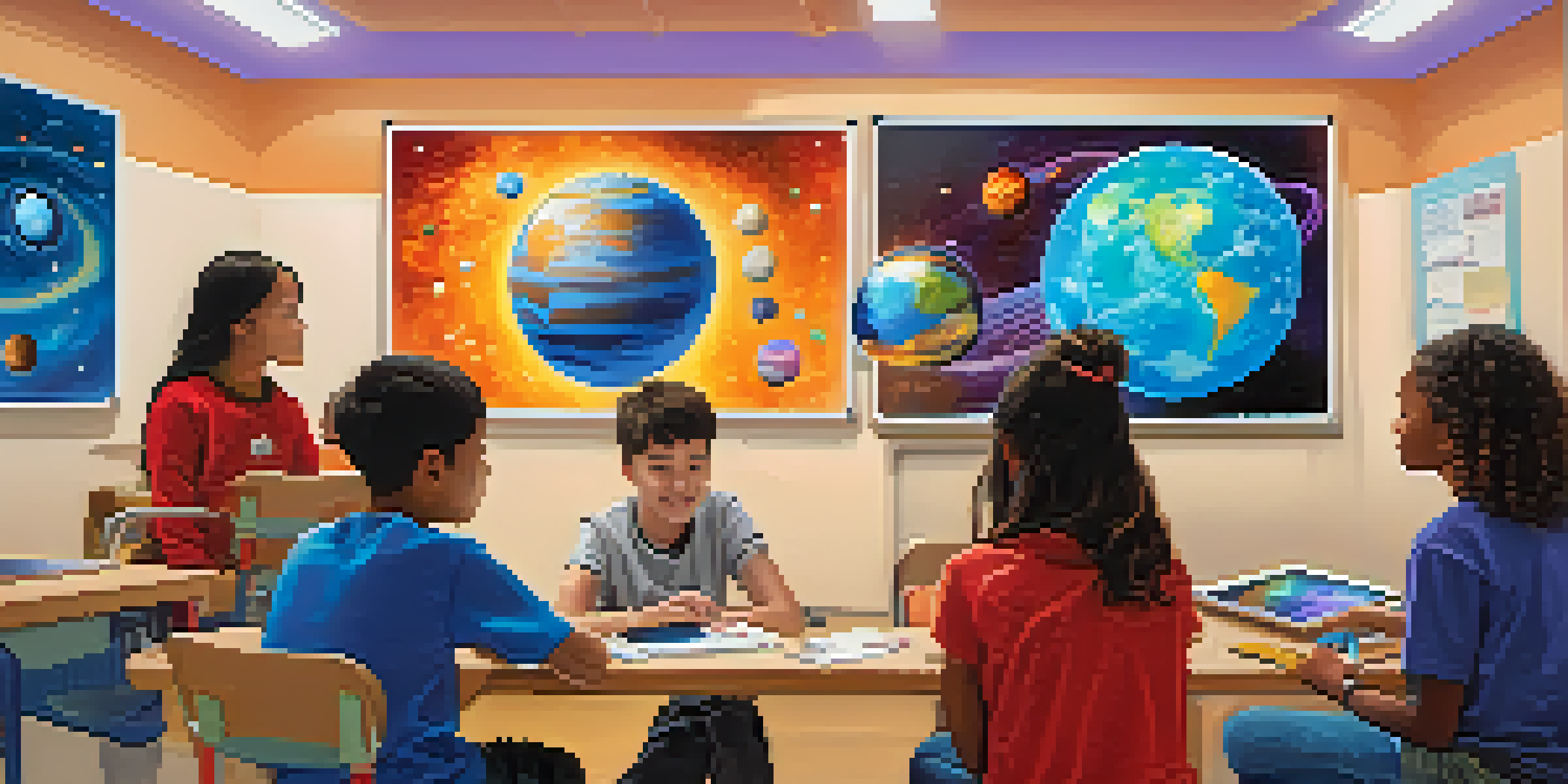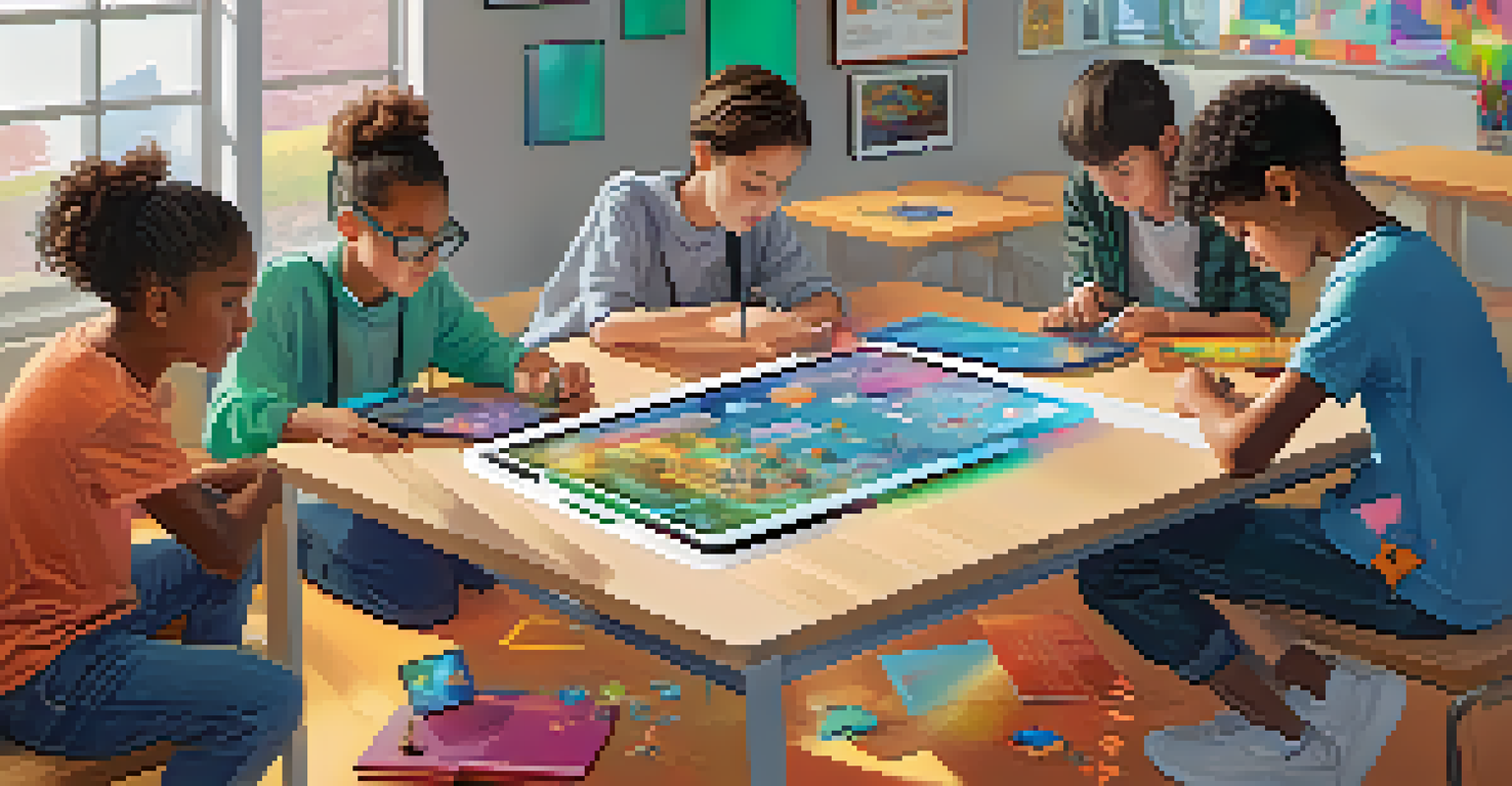Augmented Reality in Educational Gaming: A New Frontier

Understanding Augmented Reality in Education
Augmented Reality (AR) blends digital content with the real world, enhancing the way we interact with our surroundings. In education, this technology allows students to visualize complex concepts, making learning more engaging and interactive. Imagine a history lesson where students can see ancient civilizations come to life right in their classroom!
The great aim of education is not knowledge but action.
Using AR in education helps bridge the gap between theory and practice. Instead of reading about the solar system, for example, students can use AR to explore 3D models of planets as if they were floating right in front of them. This immersive experience caters to different learning styles, making it easier for everyone to grasp new ideas.
As we continue to explore the potential of AR, it's clear that it opens up new avenues for creativity and innovation in educational gaming. By merging fun with learning, AR not only captures students' attention but also encourages them to think critically and problem-solve in real-time.
How Educational Games Utilize Augmented Reality
Educational games powered by AR offer interactive experiences that keep students engaged. For instance, games like 'Minecraft: Education Edition' allow learners to build and explore virtual worlds, reinforcing concepts in subjects like math and science. This hands-on approach enhances retention and fosters a love for learning.

These games often involve challenges and quests that require students to apply their knowledge creatively. By solving problems in a game format, learners can practice skills in a low-pressure environment, which boosts their confidence. It’s like turning the classroom into an exciting adventure where every lesson is a new challenge!
AR Enhances Learning Engagement
Augmented Reality transforms traditional lessons into interactive experiences, making complex concepts easier to grasp.
Furthermore, AR educational games can be tailored to fit various curricula and skill levels, ensuring that all students benefit from the experience. Whether it’s learning a new language or mastering coding, AR can adapt to meet diverse educational needs, making it a valuable tool in modern classrooms.
The Benefits of AR in Educational Gaming
One of the most significant benefits of AR in educational gaming is increased engagement. When students interact with digital elements in their real environment, they find learning more exciting and relevant. This heightened interest often translates to better attendance and participation in lessons.
Education is the most powerful weapon which you can use to change the world.
Moreover, AR fosters collaboration among students. Many educational games encourage teamwork, helping learners develop social skills while they tackle challenges together. Picture a group of students solving puzzles in a game; not only are they learning, but they're also building friendships and communication skills.
Additionally, AR can provide instant feedback to students, allowing them to learn from their mistakes in real-time. This immediate reinforcement helps them to grasp concepts more quickly and effectively, paving the way for a deeper understanding of the material.
Challenges Facing AR in Educational Gaming
Despite its numerous benefits, the integration of AR in educational gaming comes with challenges. One of the primary hurdles is the cost of technology, which can be a barrier for schools with limited budgets. Investing in AR tools and devices is essential, but it can be a significant financial commitment for many institutions.
Another challenge is the need for teacher training. Educators must be equipped not only with the technology but also with the knowledge to integrate AR effectively into their teaching strategies. This requires ongoing professional development and support, which can be resource-intensive.
Collaboration in Educational Games
AR educational games promote teamwork and social skills as students solve challenges together.
Lastly, there's the issue of accessibility. Not all students have the same access to technology outside of school, which can create disparities in learning opportunities. It’s crucial for educational institutions to find ways to ensure that all students can benefit from AR experiences, regardless of their circumstances.
The Future of AR in Educational Gaming
As technology continues to evolve, the future of AR in educational gaming looks promising. We can expect to see even more sophisticated applications that will enhance learning experiences further. Imagine virtual field trips where students can explore historical sites without leaving their classrooms!
Moreover, advancements in mobile devices and AR software will make these tools more accessible to a broader range of students. As more schools adopt AR technology, we'll likely see it become a standard part of the educational landscape, much like computers and tablets have in recent years.
In the coming years, the collaboration between educators, game developers, and tech companies will be essential in shaping the future of AR in education. Together, they can create innovative solutions that will not only enhance learning but also prepare students for a tech-driven world.
Real-World Examples of AR in Educational Gaming
Several educational games have already successfully integrated AR technology. For instance, 'Pokémon GO' has been used in classrooms to teach geography and ecology in an engaging way. Students can go outside and interact with the game, learning about local wildlife and ecosystems as they play.
Another example is 'Zombies, Run!,' which combines fitness with storytelling. Players must run in real life to complete missions and collect supplies in a post-apocalyptic world. This game encourages physical activity while also engaging players in narrative-driven learning.
Challenges of AR Integration
The adoption of AR in education faces hurdles like technology costs, the need for teacher training, and accessibility issues.
These examples demonstrate how immersive experiences can enhance learning and make it enjoyable. By harnessing the power of AR, educators can create memorable lessons that resonate with students long after they've left the classroom.
Getting Started with AR in Your Classroom
If you're an educator looking to introduce AR into your teaching, the first step is to explore available resources. Many platforms offer AR tools specifically designed for educational purposes, making it easier to find the right fit for your classroom. Websites like Merge Cube and Quiver offer fun and interactive AR experiences for various subjects.
Additionally, consider collaborating with other teachers to share ideas and resources. By pooling knowledge and experiences, you can create a more comprehensive approach to integrating AR in your curriculum. It could even lead to exciting cross-curricular projects that engage students in new ways.

Finally, start small. Introduce AR elements gradually into your lessons to gauge student interest and engagement. As you discover what works best, you can expand your use of AR in educational gaming, transforming your classroom into an exciting hub of learning.